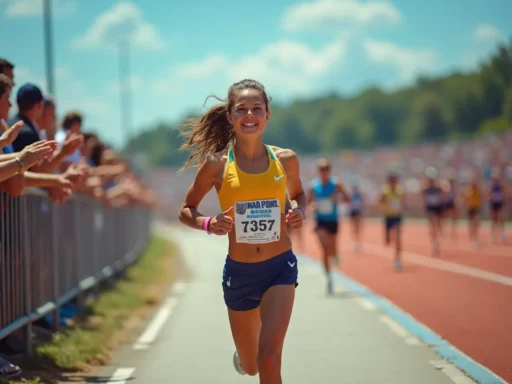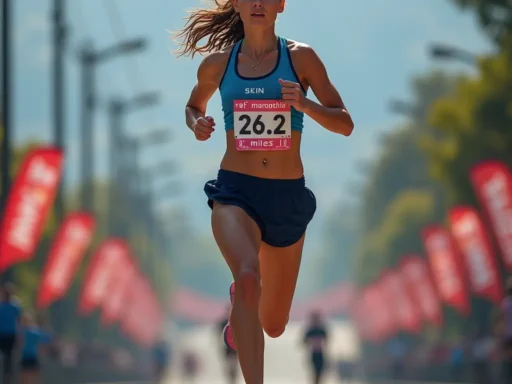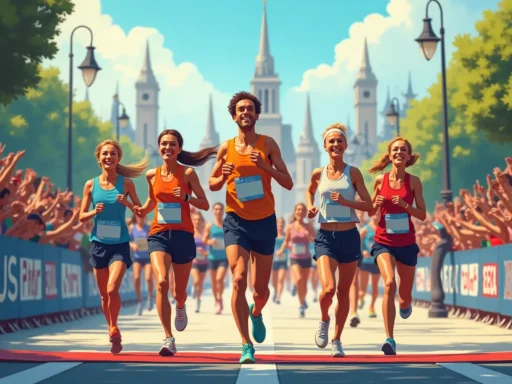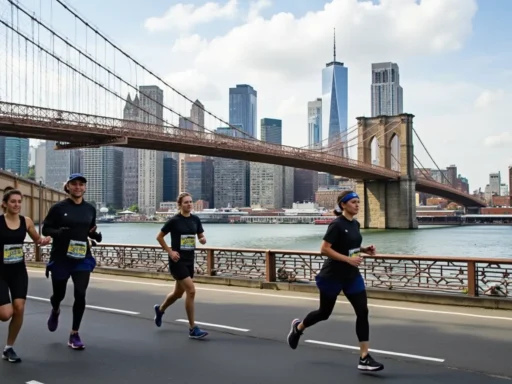We often ask ourselves when running was invented. The answer is about 2 to 3 million years ago, say evolutionary biologists. Running has been key to human evolution, helping early humans survive and hunt.
The history of running is both fascinating and long, spanning millions of years. We’re excited to explore this journey with you. We’ll uncover when running was invented and how it has changed over time.
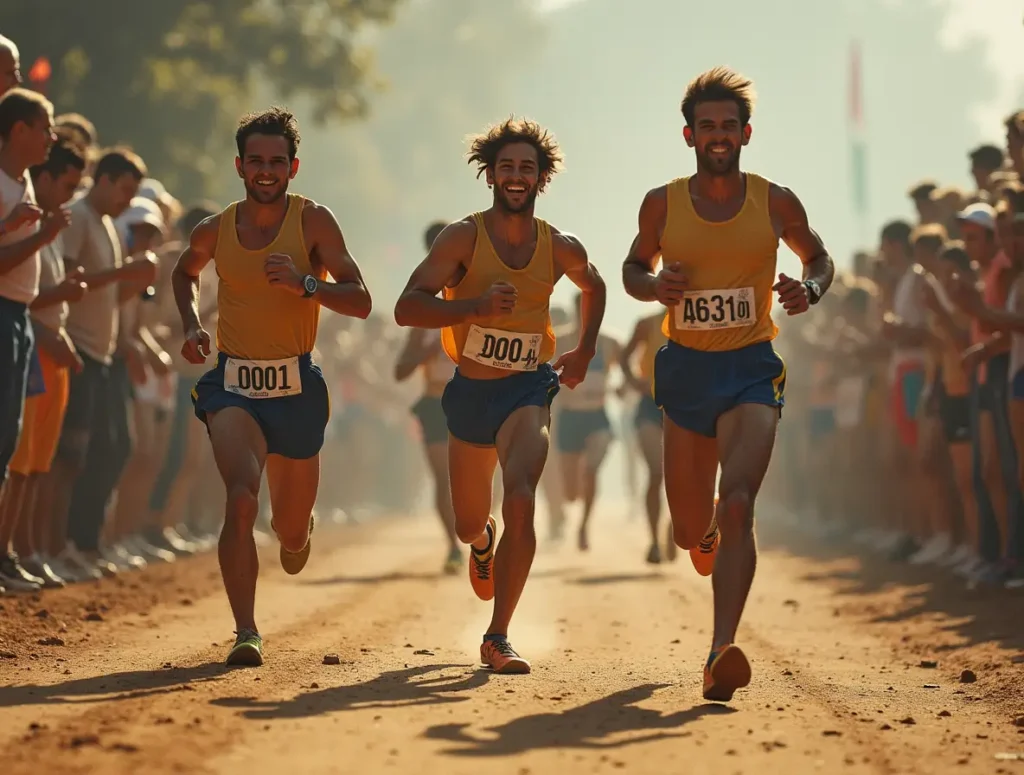
Running has been important in human culture since ancient times. The Tailteann Games in Ireland, dating back to around 1829 BCE, were the first recorded running competition. Today, running is a big part of the Olympics.
Running has been used for many things, like hunting, warfare, and fun. Whether you’re a pro runner or just starting, knowing the history of running is rewarding. It helps us appreciate this timeless activity and answers the question of when running was invented.
Table of Contents
The Origins of Human Running: An Evolutionary Perspective
Exploring the history of running, we find it’s deeply rooted in our evolution. Our evolutionary origins have shaped our bodies for running. Dan Lieberman, a Harvard University professor, says we were born to run. Our short toes and foot arch make us perfect for it.
Human evolution was influenced by persistence hunting. Early humans ran long distances to catch prey. This hunting method helped our ancestors survive and shaped our bodies. Key anatomical adaptations for running include:
- A narrower pelvis compared to earlier australopithecines
- Longer strides and lower stride rates
- A strong connection between calcaneal tuber length and Achilles tendon moment arm
These changes have made humans great at endurance running. Our evolutionary origins go back about 2 million years. Bipedalism, which started 4.5 million years ago, also influenced our running ability. Our anatomical adaptations and evolutionary origins have greatly impacted our running prowess.
Ancient Running Practices in Early Civilizations
We look into how ancient civilizations like the Egyptians and Greeks used running. They saw it as a way to exercise and compete. Running was tied to their religious and cultural practices.
In ancient Greece, running was key in athletic contests. Events like the stadion, diaulos, and dolichos were popular. The stadion was about 193 meters, the diaulos was 386 meters, and the dolichos was 3,550 meters.
Some famous athletes in ancient Greece were Leonidas of Rhodes and Polites of Keramos. Leonidas won 12 Olympic titles in 12 years. Polites won three events in one morning at the 212th Olympiad. Their achievements show the high level of competition back then.
Here are some key facts about ancient running practices:
- The ancient Olympic Games lasted from 776 BCE to about 393 CE, lasting around 1,169 years.
- Organized athletic contests in Greece go back nearly 3,000 years.
- By the 6th century BCE, there were four major Greek sporting festivals: the Olympic, Pythian, Nemean, and Isthmian Games.
These ancient civilizations greatly influenced today’s running practices. They emphasized competition, athleticism, and cultural importance. As we delve into running’s history, we honor their lasting impact on the sport.
| Event | Distance | Introduction Year |
|---|---|---|
| Stadion | 193 meters | 776 BCE |
| Diaulos | 386 meters | 724 BCE |
| Dolichos | 3,550 meters | 720 BCE |
When Was Running Invented as a Competitive Sport?
Running has been a competitive sport for thousands of years. It started with the ancient Greek Olympic Games in 776 BCE. Athletes competed in different distances and styles, marking the beginning of running as a sport.
The ancient Greek Olympic Games were key in shaping running. The stade race, about 200 meters, was a favorite. Other events like the diaulos and dolichos also featured running. The Romans also influenced the sport, adding events like chariot and foot racing.
Ancient Greek Olympic Games
The ancient Greek Olympic Games were a turning point for running. They had various running events, including the stade and diaulos. Athletes trained hard to compete in these events.
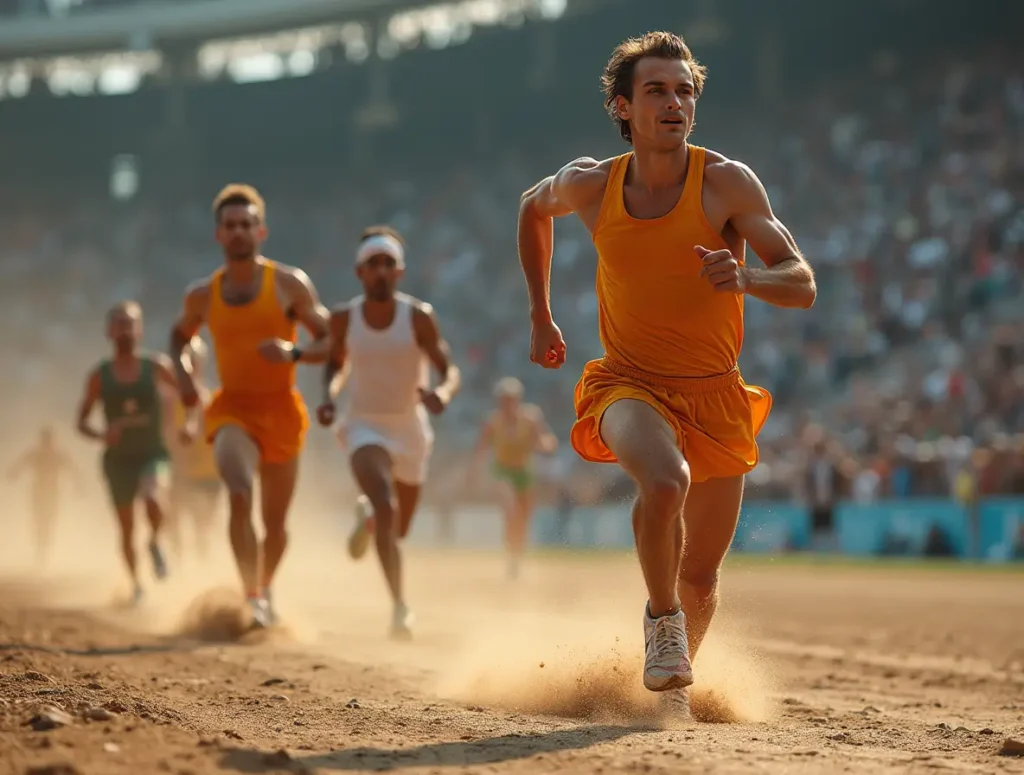
Roman Racing Traditions
The Romans also played a big role in running’s history. They kept the Greek events and added new ones like chariot and foot racing. These events became popular in the Roman Empire.
Medieval Running Competitions
In the Middle Ages, running competitions kept evolving. The first hill race was in Braemar, Scotland, between 1040 and 1064. Events like the Crick Run, starting in 1838, also became popular. These helped create the modern competitive running we know today.
The Cultural Significance of Running in Indigenous Societies
Running is deeply rooted in the culture and spirituality of indigenous societies worldwide. It’s more than just a physical activity; it’s a key part of their heritage. For example, the Tarahumara people of Mexico have a long tradition of long-distance running.
The Tarahumara are known for their incredible endurance and running skills. Some members can run up to 24 miles in just a few hours. This shows how important running is to them. It’s not just for fun or to get around; it’s a vital part of their lives.
Some key aspects of Tarahumara running culture include:
- Community foot races, known as palillo, which can stretch over several hundred miles and last for days, highlighting the cultural significance of running in indigenous societies.
- Kickball races, called dalahípu, which involve teams of up to 12 men running between 2 to 12 miles and passing a wooden ball, demonstrating the importance of running in their cultural practices.
- Women’s races, called dowérami, which utilize sticks and hoops instead of a ball, showcasing the inclusivity of running in Tarahumara culture and its cultural significance.
Running has been crucial to indigenous societies for centuries. It helps them communicate, trade, and share culture. As we learn more about running’s history, we must value its role in indigenous cultures. It’s essential to understand its significance in their daily lives and traditions.
Running in Military History and Training
Running has been key in military history. Ancient warriors used it to boost endurance and strength. King Taharka of Egypt even had a 100 km race to keep his army in shape, like today’s ultradistance races.
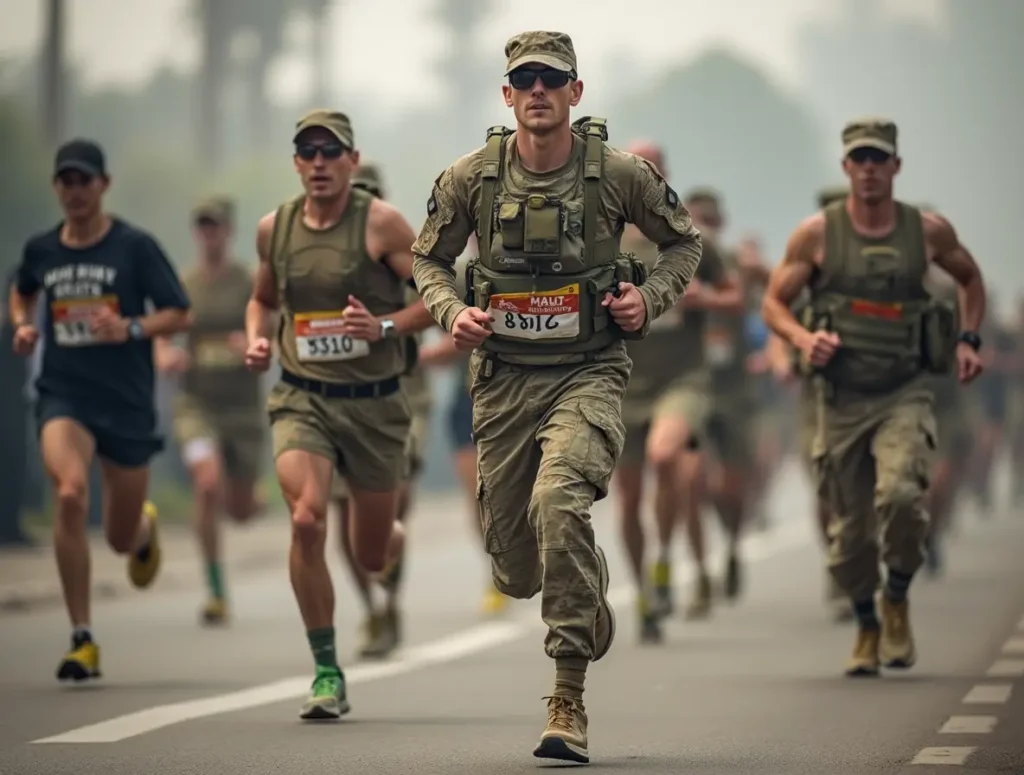
In today’s world, running training is vital for military prep. Soldiers must meet fitness standards, with running being a big part. Running boosts heart health, speed, and agility, making soldiers more fit overall.
Ancient Warriors and Running
Ancient warriors, like those in Egypt and Greece, ran to build endurance and strength. This was crucial for battle, where they had to run long distances and fight for hours.
Modern Military Running Standards
Today, military running standards differ by country and branch. But most require soldiers to run certain distances in set times. This keeps soldiers fit and ready for duty.
Examples of modern military running standards include:
- Completing a 2-mile run in under 14 minutes
- Running 1.5 miles in under 10 minutes
- Finishing a 5km run in under 25 minutes
These standards show how crucial running is in military training. They highlight the need for soldiers to be physically fit.
The Birth of Modern Track and Field
The modern sport of track and field started in the late 19th century. The first modern Olympic Games in 1896 helped make it a competitive sport. This was the start of a new era in athletics, with the birth of track and field as we know it today.
In the late 19th century, athletic clubs and organizations formed. They helped set rules for track and field events. The Amateur Athletic Association (AAA) in Britain, founded in 1880, was a key player. In the United States, the New York Athletic Club, established in 1866, promoted amateurism. These groups helped modern track and field grow, with its wide range of events.
Some key events helped track and field grow. These include:
- The first Wenlock Olympian Games in 1851, with a half-mile foot race and a leaping competition
- The National Olympian Association’s Olympian Games in 1866, which drew over 10,000 spectators
- The USA Outdoor Track and Field Championships, starting in 1876
These events show how popular track and field became. As we look into the history of running, we’ll see how modern track and field has changed. It has a rich history and exciting competitions.
The Evolution of Running Footwear
The world of running shoes has changed a lot over time. Early runners wore sandals, but now we have high-tech shoes. Joseph William Foster created spikes for the 1924 British Olympic Team, marking a big step forward.
Today, running shoes aim to be comfortable, supportive, and fast. Brands like New Balance, Mizuno, and Adidas offer many options. They use new materials and designs, like “super foams,” which are strong yet light.
Modern shoes like the Hoka Bondi 8, Brooks Glycerin 21, and New Balance Fresh Foam X 880v14 are top choices. They have cool features like lattice technology and Speedroll Technology. Prices range from $99.58 to $179.95.
| Model | Price Range | Ratings |
|---|---|---|
| Hoka Bondi 8 | $99.58 – $165.00 | 4 stars from 5,676 reviews |
| Brooks Glycerin 21 | $129.95 – $160.00 | 4 stars from 514 reviews |
| New Balance Fresh Foam X 880v14 | $101.73 – $139.99 | 4 stars from 281 reviews |
The running footwear world keeps getting better, focusing on being green. Brands like On Running and HOKA are making shoes that can be recycled. They use eco-friendly materials to help the planet.
Running as a Recreational Activity
Running has become a favorite recreational activity in recent years. Many people enjoy it as a hobby. This is because they’ve learned about the health benefits of running for fun.
Some key benefits of running include:
- Improved cardiovascular health
- Increased stamina and endurance
- Weight management
- Reduced stress and anxiety
A study at the Cooper Clinic showed runners have a 45% lower risk of heart disease. They also live 3 years longer than nonrunners over 15 years.
Running is recognized as one of the most accessible sports globally, attracting participation across various age groups and fitness levels.
| Year | Number of Runners | Event |
|---|---|---|
| 1970 | 110 | Peachtree Road Race |
| 1975 | 1,000 | Peachtree Road Race |
| Present | 60,000+ | Peachtree Road Race |
Running is getting more popular, with big events like the Peachtree Road Race drawing thousands. Running, whether for fun or competition, offers many benefits. It’s a great way to boost your health and wellbeing.
The Science Behind Human Running Capabilities
Exploring the science of running shows us how complex and detailed human running is. The biomechanics of running are key to how well we run. Knowing these can help us train better and run more efficiently.
The study of running focuses on how our bodies move and react to running. By looking at running biomechanics, we learn how to run better and avoid injuries.
Biomechanics of Running
Biomechanics of running is about studying how our bodies move and the forces acting on us. It looks at how our legs, arms, and torso move. It also examines the forces like gravity and friction.
Energy Systems in Running
Energy systems in running talk about how our bodies make energy for running. There are aerobic and anaerobic systems. They work together to give us the energy we need to run.
Running Economy and Efficiency
Running economy and efficiency are about using energy wisely while running. It’s about making our movements and energy use better. This helps us run longer and faster without getting tired.
| Factor | Description |
|---|---|
| Biomechanics | The study of the movement and forces that occur during running |
| Energy Systems | The ways in which the body generates energy for running |
| Running Economy | The ability of the body to use energy efficiently during running |
Understanding the science of running and its biomechanics helps us appreciate the complex factors at play. This knowledge can improve our training and technique. It leads to better running and less chance of getting hurt.
The Marathon’s Historical Journey
Exploring the marathon history is fascinating. It starts with ancient Greece, where messengers ran long distances. Pheidippides, for example, ran from Marathon to Athens in 490 BCE, covering about 26.2 miles.
The historical journey of the marathon includes key moments. The first modern Olympic marathon was in 1896, won by Spyridon Louis in 2:58:50. The distance was set at 26.2 miles in 1908 in London. Today, over 800 marathons are held worldwide every year.
Some interesting facts about the marathon’s history are:
- The first U.S. marathon was in Boston in 1897.
- The New York City Marathon, starting in 1970, is the largest in the U.S.
- Women were not allowed to run marathons until the 1970s.
The marathon has grown a lot since it began. World records are set and broken often. As we learn more about the marathon history and its historical journey, we see the hard work and determination of athletes.
| Year | Event | Distance | Winner | Time |
|---|---|---|---|---|
| 1896 | First modern Olympic marathon | 40 kilometers | Spyridon Louis | 2:58:50 |
| 1908 | Olympic Games | 26.2 miles | Johnny Hayes | 2:55:18.4 |
| 2023 | Men’s marathon world record | 26.2 miles | Kelvin Kiptum | 2:00:35 |
Running Records Through the Ages
Exploring the history of running shows how records have been set and broken. Athletes have always pushed their limits, achieving amazing feats. These records inspire and motivate runners today.
Running records are a big part of the sport’s history. Athletes keep trying to do better. Advances in training, equipment, and technology have helped them achieve more.
Notable Speed Records
Records like the 100-meter dash show incredible speeds. Usain Bolt holds the record with a time of 9.58 seconds in 2009. In distance running, Eliud Kipchoge’s marathon record is 2:01:39.
Distance Running Milestones
Distance running has seen big milestones. The first marathon was about 25 miles in ancient Greece. Now, we have ultra-marathons like the Comrades ultramarathon, which is 89 kilometers long.
| Event | Distance | Record Holder | Time |
|---|---|---|---|
| Marathon | 42.2 km | Eliud Kipchoge | 2:01:39 |
| Comrades Ultramarathon | 89 km | Frith van der Merwe | 5:27:00 |
| 100-meter dash | 100 m | Usain Bolt | 9.58 s |
These records show how far running has come. Athletes keep setting new records. It’s exciting to think about what’s next in running.
The Impact of Technology on Running
Technology has changed running a lot. It helps us train better, track our progress, and connect with other runners. Wearable devices and online platforms let us monitor our performance and set goals.
Technology has changed how we train. For instance, GPS tracking lets us know our distance, pace, and route. Online platforms give us personalized training plans and support, helping us reach our goals.
Technology brings many benefits to running. Some are:
- Improved performance tracking and analysis
- Personalized training plans and coaching
- Enhanced safety features, such as GPS tracking and emergency alerts
- Increased connectivity with the running community
As technology gets better, so will running. We’ll see new things like artificial intelligence-powered training and virtual reality running. Technology makes running more fun, accessible, and rewarding for everyone.
| Technology | Benefit |
|---|---|
| Wearable devices | Accurate performance tracking |
| Online training platforms | Personalized coaching and support |
| GPS tracking | Enhanced safety features |
Professional Running as a Career
Professional running has become a real career choice for many athletes. Modern training and competition circuits have made it possible. Runners can now compete and make a living from their sport. This path requires dedication and hard work, but it offers great rewards.
Many successful runners have turned their passion into a career. They have access to top coaching, facilities, and gear. This helps them perform at their best. The competition circuits give them a stage to show their skills against the world’s top runners.
Modern Athletic Training
Modern training is key to professional runners’ success. It includes physical conditioning, nutrition advice, and mental preparation. Runners work with coaches to create personalized plans. This helps them reach their goals.
- Periodized training plans to optimize performance
- Strength and conditioning exercises to improve power and endurance
- Nutritional advice to fuel the body for optimal performance
- Mental preparation techniques to develop focus and resilience
Competition Circuits
Competition circuits are where professional runners compete and earn. These circuits include local races to international championships. The Diamond League and World Marathon Majors are among the most prestigious.
| Competition Circuit | Events | Prize Money |
|---|---|---|
| Diamond League | 14 events | $1 million |
| World Marathon Majors | 6 events | $500,000 |
In conclusion, professional running is a viable career for many athletes. Modern training and competition circuits offer chances to compete and earn. As the sport grows, we’ll see more talented runners at the top level.
Health Benefits and Modern Running Culture
Running is more than just a way to stay fit. It’s a journey that offers many health benefits. It can improve your heart health, lower stress, and even make you feel happier. Today, running is a popular activity that brings people together.
The modern running culture has grown a lot. Now, there are many types of races and events. This makes running fun and welcoming for everyone, no matter their fitness level.
Some key parts of modern running culture include:
- More people are joining running events, with nearly 60 million in the U.S. in 2017
- Running clubs and groups are forming, focusing on community and fun
- There’s better technology and gear, like running shoes and clothes, to help you run better and safer
Running is a great way to stay healthy and meet new people. It’s a sport that combines fun, socializing, and personal growth. By joining the running community, you can improve your health and make lasting connections.
| Year | Number of Runners in the U.S. | Notable Events |
|---|---|---|
| 2017 | 60 million | Increased participation in running events |
| 1972 | 25 million | Beginning of the “Running Boom of the ’70s” |
| 2019 | N/A | 715 marathons scheduled across the U.S. |
Running: A Timeless Human Activity
Running has been a part of human life for thousands of years. It dates back to the Paleolithic era, about 2.6 million years ago. This activity has united people, forming global running communities that go beyond borders and cultures.
Running’s importance is clear in its role in society, from ancient times to today. It has been used for communication, travel, and fun. It has greatly influenced human history. Today, it motivates and inspires millions worldwide, with countless running events each year.
Running has had a big impact on society. Here are a few examples:
- The ancient Olympic Games, which featured running events and promoted international competition
- The modern Olympic Games, which continue to feature various running events and showcase athletic performance
- The establishment of major marathons, such as the Boston Marathon and the New York City Marathon, which have become iconic events in the running community
| Event | Year Established | Participants |
|---|---|---|
| Boston Marathon | 1897 | 30,000+ |
| New York City Marathon | 1970 | 50,000+ |
| London Marathon | 1981 | 40,000+ |
In conclusion, running is a timeless human activity that has greatly influenced society for thousands of years. It has brought people together, forming global running communities that continue to inspire and motivate people worldwide.
The Enduring Legacy of Human Movement
Looking back at the history of running, we see a lasting legacy. It shows our drive to push limits and our connection to our past. From ancient hunters to today’s marathon runners, running is a part of our shared story.
Competitive running has grown from ancient Greece to today’s global events. It shows our need to test ourselves and celebrate our bodies’ strength. Running brings people together, creating a global community of fans and athletes.
The future of running looks bright, inspiring us to reach new heights. With new tech and more people running for fun, the story of running is still unfolding. We’re excited to see what’s next in this journey of human achievement.
FAQ
When was running invented?
Running is a basic human activity that has been around for ages. Its exact start is hard to say, but it’s been key in human history.
What are the evolutionary origins of human running?
Our ancestors evolved to run. They had special body parts like Achilles tendons and big gluteal muscles. These helped them chase prey over long distances.
Also, becoming bipedal helped us run better.
How was running used in ancient civilizations?
In ancient times, like in Egypt and Greece, running was important. It was used for exercise, competitions, and in religious rituals.
When did running become a competitive sport?
Running became a competitive sport in ancient Greece. The first races were at the ancient Olympic Games. It was also big in Roman and medieval times.
How has running been culturally significant for indigenous societies?
For many indigenous groups, running is very important. It’s used for communication, trade, and spiritual practices.
What is the role of running in military history and training?
Running has always been part of military training. It builds endurance and strength. It also helps soldiers in tactics.
How did modern track and field emerge?
Modern track and field started in the late 19th century. The modern Olympic Games helped it grow.
How has running footwear evolved over time?
Running shoes have changed a lot. From simple sandals to high-tech shoes, they’ve improved a lot. This is thanks to new materials and technology.
How has running become a popular recreational activity?
Running is now a favorite hobby for many. It’s good for your body and mind. It’s also a great way to meet people.
What are the scientific principles behind human running capabilities?
Running is studied in science. It looks at how our bodies work when we run. This helps us run better.
What is the history of the marathon?
The marathon started in ancient Greece. It’s now a famous race around the world. It’s a big achievement for athletes.
How have running records been set and broken throughout history?
Running records have been broken many times. These records show amazing speed and endurance. They inspire many runners.
How has technology impacted the sport of running?
Technology has changed running a lot. It includes better shoes, clothes, and gadgets. These help runners train and compete better.
What is the world of professional running like?
Professional running is very competitive. Top athletes train hard and compete in big races. They make a living from their sport.
What are the health benefits and cultural impacts of running?
Running is good for your health. It’s also great for your mind. It brings people together and encourages an active lifestyle.
How is running a timeless human activity?
Running has been important for centuries. It connects people across cultures and ages. It still plays a big role today.

